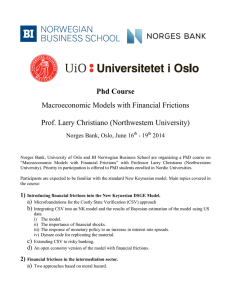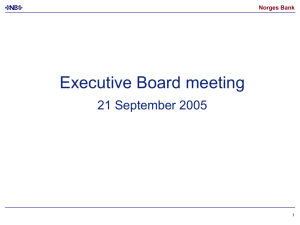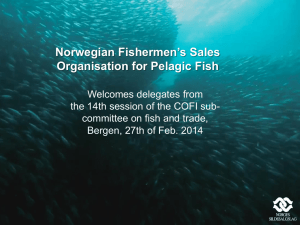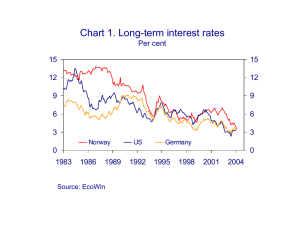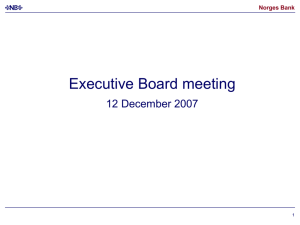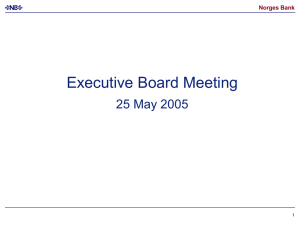How do central banks evaluate their models? The case of NEMO
advertisement
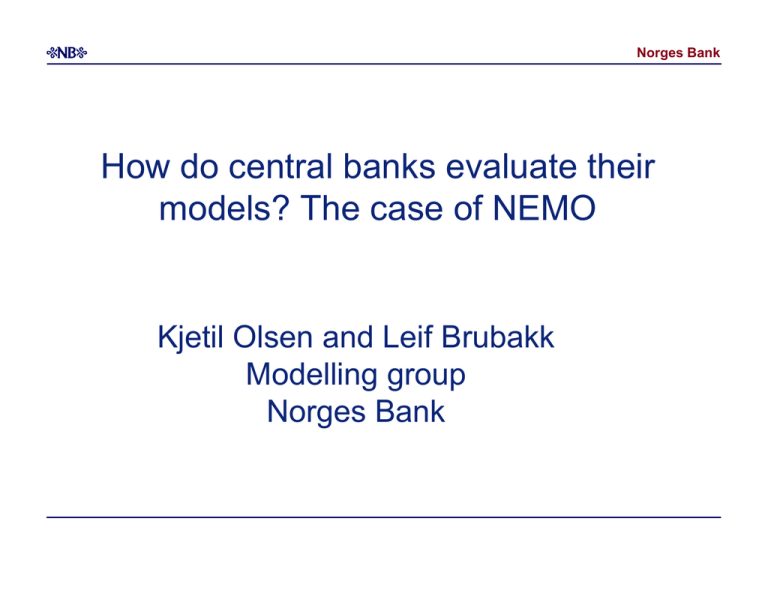
Norges Bank How do central banks evaluate their models? The case of NEMO Kjetil Olsen and Leif Brubakk Modelling group Norges Bank Norges Bank Overriding evaluation criteria from a central bank perspective: “How useful the model proves to be in helping the policy makers conduct monetary policy” Norges Bank The context • Norges Bank has operated a flexible inflation targeting regime since March 2001 • Key questions to be answered: – What should interest rates be now and in the future? – What constitutes robust monetary policy? Norges Bank Key tasks • Identifying shocks / making projections • Risk analysis and policy analysis • Communication Norges Bank A core model within a suite of models • Benefits to a ‘suite of models approach’ • But for structuring and disciplining the discussion and ensuring consistency, useful to synthesise information within a flexible core model Norges Bank A core model within a suite of models • Benefits to a ‘suite of models approach’ • But for structuring and disciplining the discussion and ensuring consistency, useful to synthesise information within a flexible core model • Our solution: FPAS Norges Bank The Forecasting and Policy System Other theoretical & empirical models Current/ Nearterm analysis Regional network Core model Qualitative information and judgement Forecasts/ scenarios Policy advice Norges Bank Three dimensions Tool for policy decisions Data Theory Norges Bank Key attributes for a central bank core macroeconomic model • It must be tractable • It must be interpretable • It must work with, rather than against, the policymakers Norges Bank A core macro model must work with the policymakers Must reflect consensus views about monetary policy • In the long-run: – No trade off between level of inflation and growth rate of output – Inflation is decided by monetary policy • Monetary policy therefore has a role to play. In the core model it must be both necessary and possible that monetary policy anchors inflation at the target. • Expectations must play an explicit role and be endogenous Norges Bank Model choices in a larger context • Tension in policy-making: – Disciplined debate and decision-making – The risk of narrow thinking • Reflected in many choices: – One model versus a suite – Imposing structure versus “letting the data speak” Norges Bank Summary: Key design and evaluation criteria for a core macroeconomic model: 1. A core macro model must explain data. Moreover, it must be confronted with as much empirical evidence as possible. 2. A core macro model must reflect consensus views about monetary policy, including the premises on which inflation targeting as a framework for monetary policy is built, and about key economic relationships. In particular, a core macro model must incorporate that – there is no trade off in the long term between the level of inflation and the growth rate of real output (but there is in the short- to medium term); – monetary policy has a clear role of anchoring inflation at the target level; Norges Bank Summary: Key design and evaluation criteria for a core macroeconomic model: 3. A core macro model must reflect that agents not only take account of today’s economic policy, but also form expectations regarding future policy, and act accordingly. Expectations must be endogenous and modelled explicitly. 4. A core macro model must be interpretable, i.e have a clear and consistent economic structure and a well-defined steady state. 5. A core macro model must be tractable, that is, neither too big or complex nor too small or stylised. Norges Bank Norges Bank’s choice: NEMO • Medium size DSGE model, founded on New Neoclassical Synthesis • NEMO represent consensus views about monetary policy – – – No trade-off between inflation and output in the long term Monetary policy affects the real economy in the short to medium term Monetary policy has clear role; providing a nominal anchor • Expectations play an explicit role • Mechanisms and disturbances are economically interpretable in a consistent fashion • Well-defined steady-state. • Nominal and real rigidities to match stylised facts Norges Bank Quantifying NEMO 1. First step: Calibration based on a range of information: – – – – – – – 2. Great ratios Identified VARs Moment-analysis/stylised facts (Stock/Watson) Single equation (econometric) analysis Micro evidence Evidence from other models and countries Experience and knowledge within the institution Next step: System estimation Norges Bank Empirical evaluation • Many different “classical” approaches for estimating DSGE models considered in the literature (see RugeMurcia, 2003): ML, GMM, SMM and Indirect inference. • Mixed results, models too stylised to capture the data. • However, recently some promising work using Bayesian techniques (Smets and Wouters, Adolfson et al.) Norges Bank Empirical evaluation • Bayesian approach attractive for several reasons: – Allows for likelihood based inference – Incorporates prior beliefs in formal and consistent way – When priors are informative, more efficient estimates are obtained. – Priors reduce the problem of flat likelihood • Model evaluation along lines of Del Negro et al. – Both in-sample and out-of-sample fit against a large set of models • Other evaluation approaches Norges Bank Conclusion • Empirical model evaluation is important • But not the only concern for a central bank regarding the evaluation of how useful a core model is in helping to run monetary policy • We believe NEMO can become a useful tool for our purposes, as a core macro model within a suite of models Norges Bank How do central banks evaluate their models? The case of NEMO Kjetil Olsen and Leif Brubakk Modelling group Norges Bank The Stylised Facts: A Monetary Policy Shock Norges Bank GDP Nominal interest rate 0.1 1.2 1.0 0.0 0.8 -0.1 0.6 -0.2 0.4 0.2 -0.3 0.0 -0.4 -0.2 -0.5 -0.4 1 2 3 4 5 6 7 8 9 10 11 12 13 14 15 1 16 2 3 4 5 6 7 Real exchange rate 0.4 8 9 10 11 12 13 10 11 12 13 14 15 16 Inflation 0.2 0.05 0.0 0.00 -0.2 -0.05 -0.4 -0.10 -0.6 -0.15 -0.8 -0.20 -1.0 -0.25 -1.2 -0.30 1 2 3 4 5 6 7 Source: Bjørnland (2005) 8 9 10 11 12 13 14 15 16 1 2 3 4 5 6 7 8 9 14 15 16 Norges Bank Empirical evaluation • Traditional econometric evaluation of each equation: – – – – Fit Parameter constancy Theory consistency (satisfied by construction) Tests against rival models • The rival models may be used in the FPAS - to crosscheck the results from NEMO
